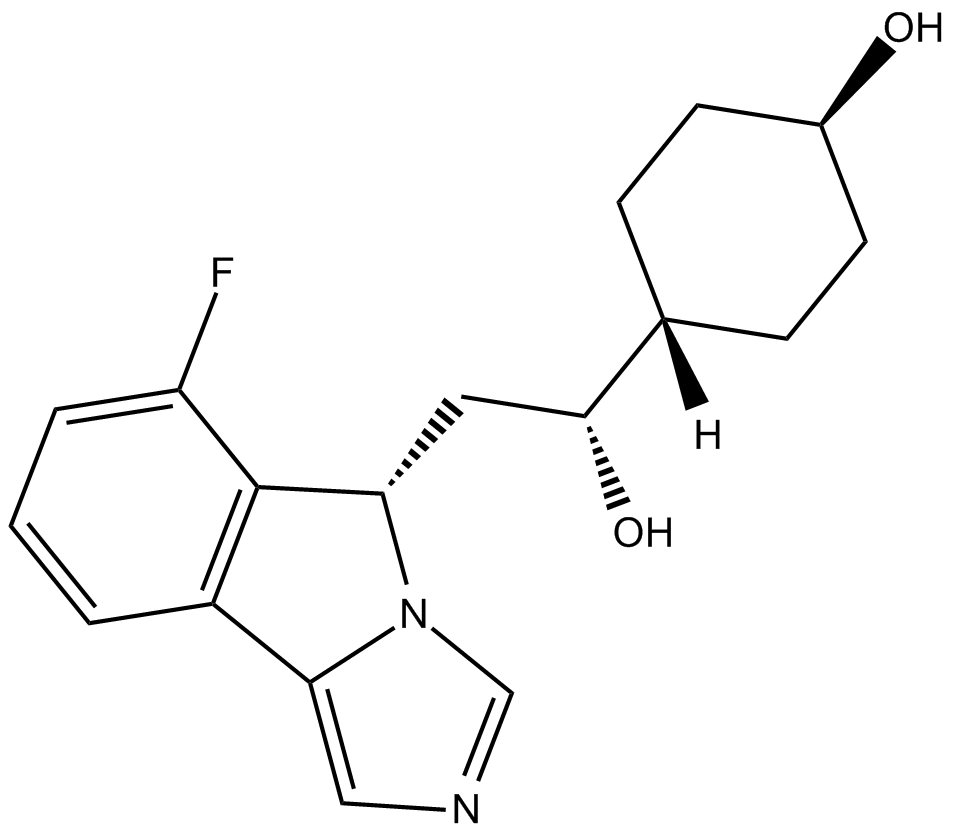Navoximod (Synonyms: GDC-0919; NLG-?919) |
| Catalog No.GC13519 |
Navoximod (GDC-0919; NLG-?919) is a potent IDO (indoleamine-(2,3)-dioxygenase) pathway inhibitor with Ki/EC50 of 7 nM/75 nM.
Products are for research use only. Not for human use. We do not sell to patients.

Cas No.: 1402837-78-8
Sample solution is provided at 25 µL, 10mM.
Navoximod (GDC-0919; NLG-919) is a potent IDO (indoleamine-(2,3)-dioxygenase) pathway inhibitor with Ki/EC50 of 7 nM/75 nM.
Using IDO-expressing human monocyte-derived dendritic cells (DCs) in allogeneic mixed lymphocyte reaction (MLR) reactions, Navoximod (NLG919) potently blocks IDO-induced T cell suppression and restores robust T cell responses with an ED50=80 nM. Similarly, using IDO-expressing mouse DCs from tumor-draining lymph nodes, Navoximod abrogates IDO-induced suppression of antigen-specific T cells (OT-I) in vitro, with ED50=120 nM[1]. Navoximod inhibits the IDO activity in a concentration-dependent manner with an EC50 of 0.95 μM. PEG2k-Fmoc-NLG(L) is less active (EC50 of 3.4 μM) in inhibiting IDO compared with free Navoximod while PEG2k-Fmoc-NLG(S) is least active (EC50>10 μM). Coculture of IDO+tumor cells with splenocytes isolated from BALB/c mice leads to significant inhibition of T-cell proliferation. This inhibition is significantly attenuated when the mixed cells are treated with Navoximod. PEG2k-Fmoc-NLG(L) is also active in reversing the inhibitory effect of tumour cells although slightly less potent than Navoximod [3].
VNavoximod (NLG919) is orally bioavailable (F>70%); and has a favorable pharmacokinetic and toxicity profile. In mice, a single oral administration of Navoximod reduces the concentration of plasma and tissue Kyn by ~50%. In vivo, in mice bearing large established B16F10 tumors, administration of Navoximod markedly enhances the anti-tumor responses of naïve, resting pmel-1 cells to vaccination with cognate hgp100 peptide plus CpG-1826 in IFA. In this stringent established-tumor model, Navoximod plus pmel-1/vaccine produce a dramatic collapse of tumor size within 4 days of vaccination (~95% reduction in tumor volume compare to control animals receiving pmel-1/vaccine alone without Navoximod)[1]. When combined with Temozolomide (TMZ)+radiation therapy (RT), both Navoximod and 1-methyl-D-tryptophan (D-1MT, indoximod) enhance survival relative to mice treated with TMZ+RT alone[2].
Reference:
[1]. Mario R. Mautino, et al. Abstract 491: NLG919, a novel indoleamine-2,3-dioxygenase (IDO)-pathway inhibitor drug candidate for cancer therapy. AACR 104th Annual Meeting 2013; Apr 6-10, 2013.
[2]. Li M, et al. The indoleamine 2,3-dioxygenase pathway controls complement-dependent enhancement of chemo-radiation therapy against murine glioblastoma. J Immunother Cancer. 2014 Jul 7;2:21.
[3]. Chen Y, et al. An immunostimulatory dual-functional nanocarrier that improves cancer immunochemotherapy. Nat Commun. 2016 Nov 7;7:13443.
Average Rating: 5 (Based on Reviews and 23 reference(s) in Google Scholar.)
GLPBIO products are for RESEARCH USE ONLY. Please make sure your review or question is research based.
Required fields are marked with *




















